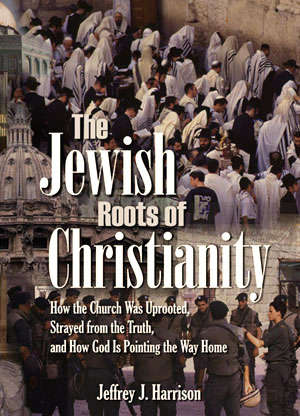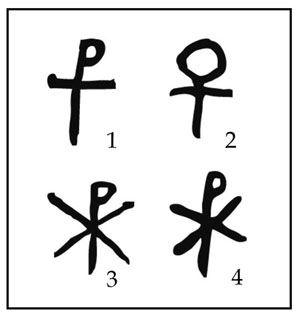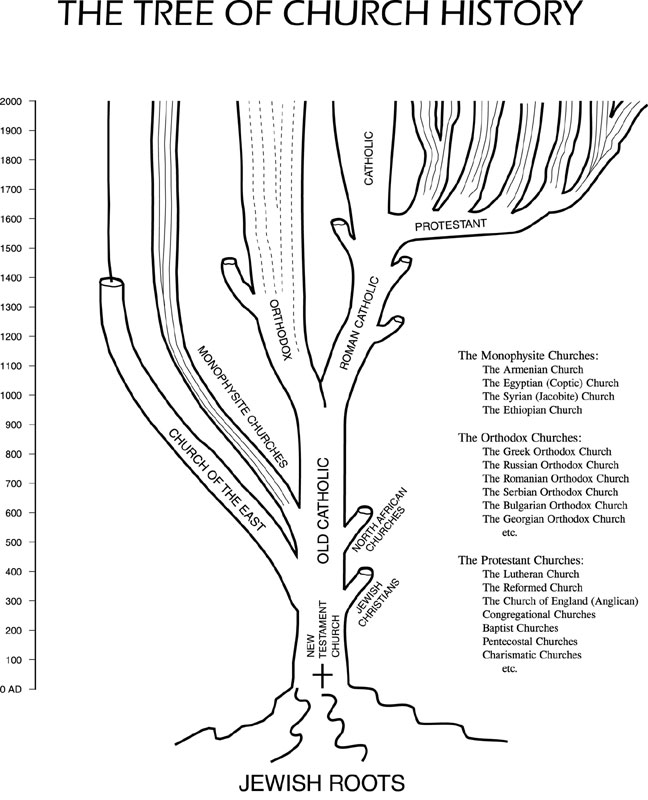The Jewish Roots of Christianity
— A Landmarks of Faith Seminar —

Lecture #3a Audio
Constantine, the Crusades, and Other Anti-Judaisms
 See notes below. (Sections in parentheses are covered in the longer form of this seminar and in the book version: available in print and on Kindle.)
See notes below. (Sections in parentheses are covered in the longer form of this seminar and in the book version: available in print and on Kindle.)Lecture #3a:
Or click here for more listening options at Internet Archive.
__________________________
Lecture #3a Notes
Rev. 12:5: “A male son [Jesus], who is about to shepherd all the nations with a rod of iron…was caught up to God and to his throne.”
Rev. 12:4: “The dragon [pagan Rome] stands before the woman [Israel] who is about to give birth, that when she gives birth, he may devour her child.”
Rev. 12:13: And when the dragon saw that he was thrown down to the earth, he persecuted the woman who gave birth to the male child.”
Rev. 12:17: “And the dragon was angry at the woman and went away to make war against the rest of her seed, those keeping the commandments of God and having the testimony of Jesus [Gentile Christians].”
The persecutions of the Emperors Decius (250) and Diocletian (303-305/311) were the worst experienced by the church in the Roman Empire.
Rev. 12:11: “And they themselves conquered him by the blood of the lamb and by the word of their testimony”
THE CONVERSION OF CONSTANTINE

Constantine: The Roman Emperor that claimed Jesus gave him victory in an important battle (The Battle of the Milvian Bridge, AD 312). Constantine marked the shields of his army with a cross-shaped sign (either 1 or 3 or 4 in the diagram). Constantine legalized Christianity and gave it a favored status in the Empire.
Matt. 26:52: “All those who take up the sword will perish by the sword”
Pontifex Maximus: Title of the high priest of pagan Rome.
Council of Nicea: The first “ecumenical council” claiming to represent the entire Church.
Caesaropapism: The Emperor (Caesar) acting as a pope over the church (papism).
Isapostolos: “Equal to the apostles.” Greek title given to Constantine by the Orthodox churches.
(Eusebius of Caesarea: “When I gaze in spirit upon this thrice-blessed soul [Constantine], united with God, free of all mortal dross, in robes gleaming like lightning and in ever radiant diadem, speech and reason stand mute…” (Life of Constantine 1.2, trans. Burckhardt, p. 250)
1 Sam. 8:6-7: “But the thing was displeasing in the sight of Samuel when they said, ‘Give us a king to judge us.’… And the Lord said…‘They have rejected me from being king over them.’”
Intolerance against the Jews: Christian mobs destroyed synagogues, Jews were forbidden to hold positions in the government or army, marriage between a Jew and Christian was ruled to be adultery with the death penalty. It was forbidden to build any new synagogues. Christians were forbidden to participate in Jewish feasts.
Hilary of Poitiers (291-371): the “Jews are a perverse people accursed by God forever.”
Gregory of Nyssa (d. 394), the bishop of Cappadocia: “The Jews are a brood of vipers, haters of goodness.”
St. Jerome (347-407): the Jews are “serpents, bearing the image of Judas, their psalms and prayers are the braying of donkeys.”
Patriarch Cyril, Bishop of Alexandria, expelled all the Jews from that great city and gave their property to a Christian mob.
John Chrysostom: “the synagogue…is a den of robbers and a lodging for wild beasts. No Jew adores God…Jews are…murderers, possessed by the devil.”
Donatists: A Christian movement in North Africa that rejected the new Imperial Church and was violently persecuted.
Augustine of Hippo: A famous Christian bishop and writer who advocated force against the Donatists.
Rev. 13:1-2: “And I saw a beast [the Byzantine Empire] ascending out of the sea… And the dragon [the pagan Roman Empire] gave him his power and his throne and great authority.”
Byzantine Empire: The name used by historians for the Roman Empire after it accepted Christianity in the time of Constantine. Rome, the original capital of the Byzantine Empire was soon transferred to Constantinople (modern Istanbul).
Rev. 13:3,6,9: “And the whole earth followed with amazement after the beast… And he opened his mouth in blasphemies against God… If anyone has an ear, let him hear.”
(Athanasius: “Satan, because there is no truth in him, breaks in with axe and sword. But the Savior is gentle, and forces no one to whom he comes, but knocks and speaks to the soul.... For the truth is not preached by sword and dungeon, by the might of an army, but by persuasion and exhortation. How can there be persuasion where fear of the emperor is uppermost? How exhortation, where the one who contradicts has to expect banishment and death?”)
Rev. 17:6: “And I saw the woman [the harlot, Babylon (false, compromised Christianity)] getting drunk from the blood of the holy ones, that is, from the blood of the witnesses of Jesus”
THE COUNCIL OF NICEA
Homoousios: Greek for “same nature.” This Greek philosophical term, introduced into the Nicean Creed, later led to much doctrinal controversy.
(Two Natures in Christ: His humanity and his divinity. The Western church emphasized the distinction of these two natures. The Egyptian and West Syrian churches emphasized the unity of these two natures. The Church of the East (the East Syrian church) emphasized the duality of the two natures.)
Church of the East: The Persian (East Syrian) church that later reached as far as India, China, and Mongolia. Also known as the Nestorian Church. This was the most Semitic major branch of the Church.
Monophysites: Also known as the Oriental Orthodox Churches. They were particularly strong in Egypt, Syria, Armenia, and Ethiopia.
Orthodox churches: Greeks, Russians, Romanians, Serbians, Bulgarians, Georgians, etc.
Roman Catholic Church: Christianity in Western Europe. Also known as the Latin church.
Protestant churches: Started in northern Europe as a protest against Roman Catholic traditions that contradicted the Bible.
(Tritheism: The heretical belief in three gods.)
(Persona: A Latin word that means something like “personality” in modern English. The original definition of the Trinity was “one God in three personae.”)
(Isa. 55:8: “For my thoughts are not your thoughts, and your ways are not my ways.”)
(John 1:18: “No one has ever seen God.”)
(Greek thinking established a false equation between purity and simplicity of spirit on one hand, and between impurity and the complexity of the material world on the other. But in the Bible, when God created the material world, he called it “good,” and the core meaning of the Trinity teaching is that God is complex.)

(Is God simple or complex? Trinity is a description of complexity in God. But since Greek philosophy assumed that spirit cannot be complex, this made it very difficult to explain the Trinity. From a Jewish point of view this was not a problem, since there was no barrier to complexity in God. God is often described in the Bible as having spiritual “parts” (his Word/Reason, Spirit/Breath, etc.).
(Impassibility: The Greek-inspired idea that God cannot suffer or experience emotion.)
(THE RISE OF THE PAPACY
(Germanic Invaders: Swept across Europe in the 5th cent. AD. They were Arians, who denied that Jesus is God (similar to the Jehovah’s Witnesses).
(Papacy: The belief that the bishop of Rome has authority over all churches because of a succession from Peter. Leo I (440-461) was the first to make this claim. Before this, Western churches were independent of one another. In support of this claim, the bishop of Rome took at this time (5th cent.) the originally pagan title Pontifex Maximus, a title once claimed by the Roman emperors, which originally referred to the chief pagan priest of the city of Rome.
(Celtic Christianity: A once independent form of Christianity that evangelized Germanic peoples all across Europe (by means of hundreds of Irish monks).
(Growth of papal control:
- 5th century: Over North Africa, Spain, and France.
- 6th century: Over the bishops of Italy.
- 7th century: Over Scotland, Ireland, and Wales (the Celtic church)
- 8th century: Over Germany.
(False Decretals (865): A set of forged documents that claimed universal authority was given to the pope by Constantine. They were exposed as frauds in the 16th century. Yet they remain at the heart of Roman Catholic canon law.
(PERSECUTION OF THE JEWS
(Emperor Justinian (6th cent.): Made Judaism illegal. This led to:
(Forced Conversions: In France, in Italy, in the eastern Mediterranean. In Spain Jews could choose conversion or exile.
(The Persian Invasion (614): Tens of thousands of Christians were killed, many churches destroyed.
(Emperor Heraclius: Defeated the Persians, returned the “true cross” to Jerusalem. Led to massacres of the Jews, and:
(Forced Baptisms: In Carthage, France, Italy. In Spain, children of mixed marriages were forced to be baptized.)
ISLAM
(Muslim beliefs that trace back to Judaism:
- Muslim prayer was originally directed toward Jerusalem (later changed to Mecca).
- Many Muslim food laws are Jewish.
- Prohibition of images and idols.
- Separation of men and women in worship.
- Use of prostration in worship.
- Paradise described as a garden-like environment.
- Rabbinical teachings mentioned in the Koran.)
(Muslim beliefs that trace back to Christianity:
- Accepted Jesus as a prophet and as the Messiah.
- Defense of Mary.)
(Muslim beliefs that trace back to heretical Jewish Christianity:
- The true spirit of prophecy has been revealed in a succession of prophets, starting with Adam.
- Wine is forbidden.
- Rejection of Paul.
- The idea of Mohammed as the great Prophet of God.
- That the Scriptures are distorted, and that Mohammed came to correct these distortions.
- A carnal view of heaven: as a place of earthly delight where the practice of marriage continues.
- Judaizing: that Gentiles must keep the Law of Moses, as with food laws.
- That Jesus had not been crucified.)
(Shirk (in Arabic; shittuf in Hebrew): The “association” of an ordinary man with God, which is how both Muslims and Jews understanding the Christian doctrine of Trinity. However, Christians actually believe that the Word of God (who is God) took on humanity to become Jesus. Jesus never had an existence separate from God.)
Jihad: Muslim holy war to advance the faith of Islam. This is a central religious principle of Islam.
Mohammed said: “I have been ordered by God to fight with people till they bear testimony to the fact that there is no God but Allah and that Mohammed is his messenger.... If they do it, their blood and their property are safe from me” (Sahih Muslim 1:33).
“Seek out your enemies relentlessly” (Quran 4:104)
“Those that make war against Allah and his apostle...will be put to death or crucified or have their hands and feet cut off on alternate sides” (Quran 5:33)
“The believers that stay at home...are not equal to those who fight for the cause of Allah.... Allah has given those that fight...a higher rank.... Far richer is the recompense of those who fight” (Quran 4:95)
Houris: Beautiful women promised to Muslim martyrs in the Muslim paradise.
Poll tax (Jizya): Annual tribute paid by Jewish and Christian subjects of Islam.
Modern Muslim countries that were originally Christian or with a large number of Christians: Syria, Turkey, Egypt, Iraq, Iran, Sudan, Libya, Morocco, Algeria.
Pact of Omar: Christians could keep their churches, but: crosses were not permitted on churches or in the street, bells could not be rung, no religious images were permitted in public, no processions at festivals, no loud chanting at funeral processions, no new churches could be built. Muslims had the right to enter any Christian holy site. If a Moslem came into a meeting, you had to rise to show respect. Christians had to wear yellow stripes in their clothes, were forbidden to ride horseback, their graves had to be level with the ground. It was forbidden to strike a Moslem, or prevent a Christian from converting to Islam. Speaking out against Mohammed or Islam brought the death penalty. Conversion of a Muslim to Christianity also brought the death penalty. It was forbidden to harbor spies in churches, or to build houses taller than those of your Muslim neighbors.
Constantinople: Capital of the Byzantine Roman Empire from the 4th century AD (modern Istanbul).
Iconoclasm (the “breaking of images”): The destruction of idols and images in Christianity by the emperor Leo III and his son Constantine (beginning in 730). Also opposed the worship of Mary, the intercession of the saints, and the worship of relics.
The Second Council of Nicea (787): Officially accepted the use of images in the Christian church. Followed by more forced conversions.
(CHARLEMAGNE & THE MILLENNIUM
(The Umayyads: The Muslim dynasty that conquered Spain (711-718).
(Charles Martel: The Merovingian leader that defeated the Muslim Umayyads at Tours (732).
(Pepin: The son of Charles Martel, crowned King of the Franks by Pope Zacharias (752).
(The Papal States: Lands in Italy given by Pepin to the pope. This made the pope an earthly ruler.
(Charlemagne: The son of Pepin, crowned Roman Emperor by Pope Leo III (800). This was the rebirth of the Roman Empire in the West, the beginning of the Holy Roman Empire. Charlemagne was crowned in 6000 AM (Anno Mundi), the year in which some believed Christ would return to begin the Millennium. But Charlemagne identified this as AD 801 (using the system of counting we still use today), which implied that the end had not yet come.
(Conversion of the Saxons: Charlemagne converted the Saxons to Christianity by force (forced conversions were now being used against pagans, too: also in Hungary, Norway, Russia).
(Millennium: Was considered too Jewish and too earthly and so was rejected by many, including Augustine of Hippo. He interpreted the millennium to be this present Church age.
(Rise of the papacy:
- 1028-1085: Pope claimed sovereignty over several countries (Gregory VII)
- 1170: Pope claimed sole right of canonization of saints
- 1215: Pope declared greater than all the patriarchs of the East (Lateran Council), and was above the law. To disobey the pope was to disobey God.
- 1493/1506: The pope split the world between the Spanish and the Portuguese.
(The utopian vision for a this-worldly millennial age, a perfect monastic society gave rise to expectations of an Angelic Pope and a Last Roman Emperor (ideas derived from the Sibylline Oracles).
(The Papal Antichrist: That the pope was the Antichrist was a common theme among dissenters by the 10th cent. AD. (The idea of a present Millennium meant that the next prophetic event to take place was the coming of Antichrist with Gog and Magog for an endtime battle. This seemed to be confirmed by the attacks of the Muslims, Vikings, and others. These were no longer seen as sinners to be evangelized, but the army of Antichrist to be attacked and killed.)
THE CRUSADES
Fatimids (909-1171): Ruled from Egypt. Harassed Christian pilgrims visiting Israel.
El Hakim: The Fatimid caliph (ruler) who ordered the destruction of the Church of the Holy Sepulcher in Jerusalem (1009).
Seljuq Turks: The mistreatment of pilgrims increased (1070-).
Pope Urban II: Preached a Crusade to rescue the Holy Land from the Muslims. Crusaders were granted forgiveness of all their sins and the guarantee of eternal life. They also did not have to pay interest on loans owed to Jews and were promised they could keep any lands they conquered.
First Crusade: Of the 600,000 that participated, only 20,000 arrived at Jerusalem. Many attacked Jews along the way: more than 5,000 were killed. After taking Jerusalem, the city’s Jews were burned.
(The Albigensian Crusade: 60,000+ were killed in southern France (1209-1229). Other crusades were declared in eastern Germany, Latvia and Estonia, and Prussia.)
(The Fourth Crusade: Was directed against Orthodox Christians living in the Byzantine Empire (1204)!)
PERSECUTION OF THE JEWS
Judensau: The pig as a derogatory image of the Jews.
Ritual murder charge (blood libel): The claim that Jews ritually murdered Gentile children.
Fourth Lateran Council (1215): A church council that required the Jews to wear special clothing (a badge or three-pointed hat): the “badge of shame.”
Transubstantiation: Roman Catholic doctrine that the bread and wine of communion physically became the body and blood of Jesus. Jews were accused of stealing the consecrated bread in order to torment Christ.
Black Death: A horrible plague that swept across Europe in 1348. The Jews were blamed for poisoning the wells.